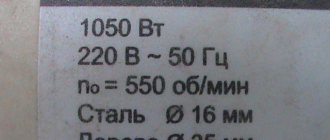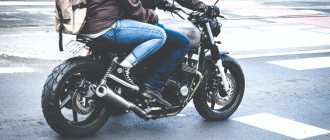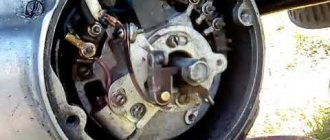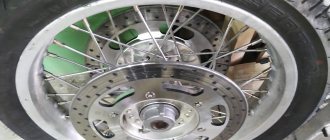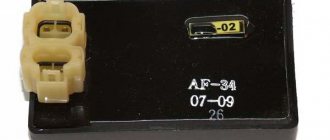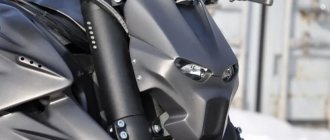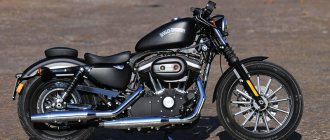Electrics, lights, music
It just so happened that I myself drew wiring diagrams for pit bikes of all types and capabilities, and I assemble the wiring for my pit bikes myself, not for the first time, and I realized something for myself.
So, another wiring option was created specifically for the pit club. The idea was to create a separate, completely permanent wiring harness that could be quickly removed, leaving only the wiring that is directly responsible for the spark.
Since I was so determined to install LED headlights everywhere, it came to a pit bike. There are no such places to properly secure the headlight, so a little ingenuity. After the first fittings, it was decided that the headlight should stand slightly above the mounting hole of the shield.
And so the FLINT headlights...they shine well, but there is a problem with the mounts on some models. We are talking about single headlights, on which the fastening to the headlight itself is, for some unknown reason, made on a groove-to-groove slide, and the whole thing is pulled together with one poor M3 screw. You understand m 3! which if you don’t tighten anything, you will either tear the thread out of the headlight housing, or the bolt itself will break off..
So, this circuit is suitable for all types of pit bikes, except for the YX 150 with a starter, where the generator has 4 output contacts. The relay regulator used in the circuit is a regular 4-pin. The generator is standard: 5-pin with windings for light.
Well, as usual, there are lazy people among us, and there are those who simply do not have the money to buy and install a battery on their pit tank to ensure normal operation of the headlight. Many people certainly need a headlight, but few people know how to connect it due to inexperience, and that’s why here’s the simplest connection diagram.
The fact is that the CNC button has constant contact with ground. When pressed, if the power wires from the starter are connected to it, everything will simply short out and burn out.
In general, all ignition coils themselves are the same on the pits. I’ll say more: the notorious Alpha and Japanese endurics have the same ignition coils.
But there is a very important difference not in the coils themselves, but in the armored wire and spark plug cap that come with the coil. It is these two elements that most often rape the brain, and the damper the weather, the more these details bother you.
Without further ado, straight to the point! The colors of the wires from the generator completely match the color of the wires on your generator! The rest of the colors are arbitrary! Red in the diagram is PLUS everywhere! Just like the black one that goes to the ignition coil! Green always and everywhere MINUS! The relay regulator in the diagram and in my pit was used not with 5 contacts, but with four! Why? Becauze I whant so!)))
Everyone has a hard time figuring out the main wiring, but the starter turned out to be a stumbling block for many, so especially for you here and now ELECTRIC STARTER CONNECTION DIAGRAM FROM AND TO)))
Source
Where to balance the crankshaft - repair options
- The static method is used for minor imbalances. In this case, the crankshaft is stationary. In this case, the heavy side is lowered down. The light side is balanced using weights that are attached to the edge of the light side. Then, using special knives, the metal is removed from the heavy part until the loaded part is lowered.
Grinding the crankshaft
- The dynamic method is more accurate than the static one. It is used to correct a significant imbalance. In this case, a special machine is needed on which the shaft is installed. The crankshaft begins to spin to the required speed. Using a laser, the point where the heaviest point is located is determined. Excess metal is removed from this place.
Will the headlight work without a battery?
There are more and more pit bikes, and the buyers are most often amateurs. Until now, many pits are not only not equipped with a full-fledged generator, but also completely lacking a headlight, although those who simply ride without a hint of a cross track really, really need one.
And, naturally, the question arises: how to connect? Yes, very simple!
First, we buy a full-fledged generator with power coils and power wire output.
For 125 motors we use a heavy generator. With it you will not lose “tractor” traction at the bottom.
For motors 140 and above, we use a lightweight generator with the same power coils and two power wires output.
And, naturally, you need a relay-regulator, from which power wires are already distributed to any lighting equipment. You can take any relay, even with 5 contacts, even with 4.
Crankshaft balancing
Re: Crankshaft balancing
Post by Lavua » Jan 26, 2012, 7:48 pm
Re: Crankshaft balancing
Post by DEEMAN » Jan 27, 2012, 05:04 pm
Re: Crankshaft balancing
Post by nemmishka » Jan 27, 2012, 8:33 pm
Re: Crankshaft balancing
Post by DEEMAN » Jan 31, 2012, 4:26 pm
Re: Crankshaft balancing
Post by P4ASF » Mar 23, 2012, 9:40 pm
Re: Crankshaft balancing
Post by Lavua » Mar 23, 2012, 10:22 pm
How to connect a headlight to a Kayo pit bike
Hello everybody. In this article we will try to tell you in an accessible form how to install a headlight on a pit bike. We all understand that everything that seems simple has various nuances, if missed, the whole work will go downhill. For this reason, we decided to write an article with general recommendations.
Also in this article we will explain how to connect a headlight to a pit bike. That is, we will highlight the available options for connecting a headlight on a pit bike. Installing lighting components on a pit bike is a fairly common question that affects every second rider. Some people need a headlight because they often ride on night roads, while others need a headlight because they frequently travel on city roads. Accordingly, the PPD obliges owners of pit bikes to equip their vehicles with a lighting device.
Dimensions and weight
The length is standard for pit bikes of this class. I can notice from myself that if an adult rides, then he will have to sit in the back almost on a spoiler.
In terms of external parameters, the brand usually adheres to the same standards. Pit bikes from Kayo have:
- length - 1755 mm;
- width - 758 mm;
- height - 1150 mm;
- seat height - 888 mm.
- wheelbase - 1224 mm.
Dry weight is only 71 kg.
If we remember that Kayo is one of the trendsetters in Chinese bikes, it is not surprising that despite different stickers on the body kit, the basic parameters of all bikes from the Middle Kingdom are identical.
How to connect a headlight on a pit bike
For understanding, let’s say that in nature there are only two options for installing a light on a pit bike. Which of the two options is right for you depends solely on whether the generator has the appropriate wiring to power the light or not. So
- Option 1. Three wires come out of the generator, one of which is insulated. An example is the Zongshen 160; there is no winding on the generator of this motorcycle. The output is to install a generator with a winding for connecting light.
- Option 2. There are 6 wires coming out of the generator, three of which are insulated. An example of this situation would be the Lifan 140. This generator has a winding for powering the light. Installing a light on a pit bike with such a motor will take 2-3 hours if you follow the instructions.
Causes of bearing wear
Otherwise, a complete replacement of the shaft or repair along the path of metal spraying is required. Do not forget also about emergency situations, such as jamming of the piston in the cylinder. This will inevitably lead to bending of the crankshaft, which, by the way, can occur during unprofessional disassembly of the motorcycle, when the shaft is knocked out with a hammer or sledgehammer.
If the bend can be eliminated, then physical damage cannot. Don’t also forget about replacing worn out oil seals in a timely manner. Replacing crankshaft oil seals on a Minsk motorcycle will allow you to avoid such troubles as the release of a gasoline-oil mixture into the generator. Many owners also experience difficulty starting the engine and a sharp drop in power.
How to make a light on a pit bike
In order to install the headlight, remove the interfering plastic, tank and switch. After installation, you need to find a suitable place to attach the relay-regulator there and hook the switch back up, just don’t forget to fasten everything back.
To install the headlight, remove the plastic that is in the way, the tank and the switch. After installation, find a suitable place to secure the regulator relay and connect the switch back, it is important not to forget to secure the green wire with a ring at the end, it leads to ground.
The headlight must be connected according to the colors of the wires. Each lamp has a bundle of wires. It happens that manufacturers use incorrect colors and then you can easily get confused about what to connect to what; the way out of this situation is to try each wire in turn.
When the connection is complete, make sure that the switch on the remote control is in the “on” position. The high and low beams work in turn and are working properly. If you have no reason to think that you did not do the job correctly, then feel free to rewind the wiring and put everything that you removed in place
How to install a headlight on a Kayo 125cc pit bike
Now let’s look at a specific option, where the basic configuration of a not-so-cheap pit bike simply does not have a headlight. But everything is not so bad, it has a winding already installed on the generator to power the light.
Installing a headlight on a kayo 125 pit bike is problematic and will require special tools. To install the relay regulator, you only need a screwdriver, electrical tape and wires.
Let’s assume that we want to leave the design the same, which means we will need something that won’t spoil the look and is compatible with the existing design of the pit. We will also not make unnecessary holes and openings. We remember that only an original headlight can be better than an additional headlight; all professionals and amateurs in car mechanic work of any vehicle strive for this.
Be prepared for the fact that it will take a lot of time to select foglights. Most people at the counter are trying to sell us high beam headlights, and the vast majority, without thinking, fashion them and blind oncoming drivers! Everyone knows how unpleasant this is. If we are talking about high beam headlights, then this is a headlight with diffused light, such that the beam looks like a low beam headlight. You will come across a large number of headlights and you can choose any one. The average cost is 200 rubles per headlight.
Next, we find the bracket on the headlight and bend it (you can use your hands - the metal is quite soft, but you can also use a tool, pliers or pliers) and choose the correct bending angle.
We drill holes. Please note that the saddle must be selected with tight mounting screws. With a normally adjusted hole, we eliminate breaking due to vibrations when driving over bumps and engine vibration.
We use screws with a large diameter so as not to use washers, which we think is a better option. We installed the bracket and move on. We remember that we need a minimum number of holes in the front of the motorcycle. A stiffening rib runs nearby, which is why the fog lamp is installed in this particular place. We tighten the headlight. There are holes in the “ears” of the bracket for adjustment, that is, if you made a small mistake when marking, it can be corrected when adjusting the fasteners.
If you follow our recommendations, you will receive an installed headlight on a Koya 125 pit bike. In this case, the light will be installed as is now popular, similar to BMW with their asymmetrical optics.
Most people think that they will face many problems when solving the question of how to connect a headlight to a kayo pit bike. The PITBIKER.RU team has studied a lot of information about capacitors, about the ground, etc.. the first thought is that this is beyond the bounds of the possible and how can we even talk about it so that it’s clear. But a great desire to tell our clients about how to install and connect a headlight to a pit bike gave us the strength to write this article.
Why is crankshaft balancing necessary?
Crankshaft balancing is carried out to reduce the load and vibration on the components of the power unit. This operation makes it possible to increase engine performance and extend service life. Basically, balancing is necessary for worn-out engine elements, but there are cases when a new car needs balancing.
Balancing the crankshaft in the garage
You can determine whether the crankshaft needs balancing by the behavior of the gear shift knob: it begins to wobble when idling. The same goes for the engine: if at idle the engine runs jerkily.
The causes of problems may be different:
- poor quality manufacturing of mating parts,
- heterogeneity of the material used for the crankshaft,
- backlashes resulting from violation of the gaps between mating elements,
- poor quality assembly,
- inaccurate centering,
- natural wear and tear.
After replacing the flywheel or its ring gear, the clutch basket, it is necessary to balance the crankshaft. If this procedure is not followed, then even at low speeds the motor will begin to vibrate due to imbalance.
Placement of wiring components
It just so happened that I myself drew wiring diagrams for pit bikes of all types and capabilities, and I assemble the wiring for my pit bikes myself, not for the first time, and I realized something for myself.
- The first thing I realized was that all the components should be in one place.
- Secondly, they must be accessible.
- Third, there should not be any clear fastenings for a certain model of components, as the Chinese are very inventive, and every time there is something new.
- Fourth - ease of removability.
- The last fifth thing is the wiring itself. It must be soldered, no twists, high-quality terminals and a decent thickness of wires.
Let's start with placement. I placed everything as accessible and protected from moisture as possible. Behind the side shield. For installation, I made a mounting plate on which you can install any type of component, the plate itself is also fastened quickly.
The regulator relay, CDI and even the starter relay, which is necessary for a motor with an electric starter, can easily be placed on this plate.
Unfortunately, I didn’t have a connector for CDI, and it’s not advisable to buy wiring for it, so the contacts are 1.5 mm, and heat-shrinkable tubes. There is essentially no difference, only in the convenience of removal. But if you know the crucible by heart, it’s not so stressful.
Since I have the same starter installed, I need a battery, I run the minus from it along the frame, pairing the wires with the minus of the regulator relay. so as not to pull unnecessary ground wires in the future.
The situation is exactly the same with the regulator relay, but if there was a trick, it would not be very convenient for me, as it is more convenient to place the wires directly from the regulator relay and one at a time.
In addition to everything, the wires themselves must be protected and not dangle anyhow, so every last wire is placed in special corrugations.
As for the headlights, of course a FLINT diode headlight is installed, only that and nothing else! Great light, great look! Durability and aluminum body! The set of these parameters makes this headlight simply ideal for installation on a pit bike!
But the headlight switch is far from modern, but from the USSR. Probably the most reliable and simplest thing there is, since it is in a metal case with a textolite base, even if you hit it with a hammer, it will not cause much damage, and its functionality will be completely intact.
Everything was assembled according to my already well-known scheme, which works great on all the pit bikes that I made, and from those who purchased wiring from me.
Source
Engine IZH Planet 3, 4 and 5, disassembly, assembly for repair and tuning
When disassembling the engine, you must first drain the oil from it and remove it from the motorcycle frame; you must wash the engine thoroughly. To do this, it is advisable to use a high-pressure apparatus (car wash) with car shampoo. Having washed the engine and protected it from getting dirt inside, we proceed to disassembly.
We remove the right engine cover, remove the generator (by unscrewing the mounting bolts). Be careful not to damage the paronite gasket; remove the cover and disassemble the box. We take out the gears with the shafts and disassemble the shift mechanism, remove the control levers from the engine, and remove the clutch cover. We completely disassemble the clutch and remove the motor chain.
We disassemble the piston, remove the cylinder head (by unscrewing the fastening nuts), then remove the cylinder. After this, remove the piston from the crankshaft, first removing the retaining rings and carefully knocking out the piston pin.
We place the engine on its left side and, carefully without damaging the heads, unscrew the connection bolts using a powerful screwdriver. Then we knock out the centering halves of the crankcase half the length of the bushing.
Disassembled parts must be washed in gasoline and carefully inspected; damaged and faulty parts must be replaced with new ones. Clean the junction of the crankcase halves from old glue
On the oil seals (cuffs), pay attention to cracks and springs. Bearings should rotate easily without jamming and should not have any play
Having prepared the serviceable parts, we begin assembly.
We assemble the engine in the opposite order of disassembly. Be sure to heat the crankcase half to the same temperature, which makes assembly easier and preserves the crankcase surface from damage during pressing. The connection of the crankcase halves must be coated with BF-4 glue.
When installing the piston on the crankshaft, it is advisable to heat it to a temperature of 60 degrees, this will help when inserting the piston pin. During assembly, you also need to lubricate the cylinder mirror and piston pin with engine oil.
